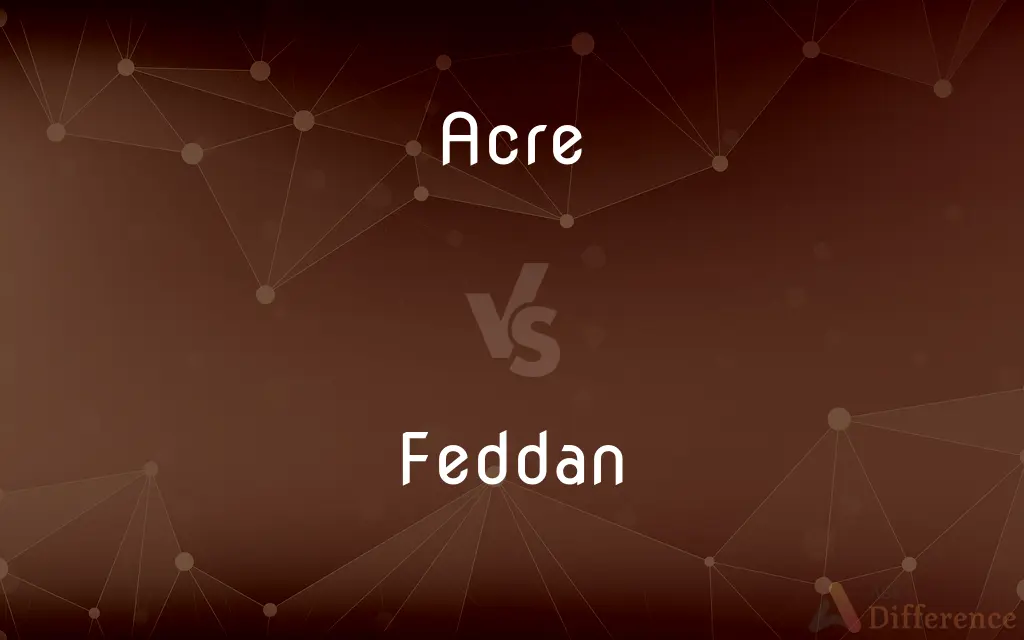Acre vs. Feddan — What's the Difference?
By Tayyaba Rehman & Urooj Arif — Updated on April 27, 2024
An acre and a feddan are both units of area measurement used primarily for land; an acre is commonly used in the United States and the United Kingdom whereas a feddan, used mainly in Egypt and some other parts of the Middle East.

Difference Between Acre and Feddan
Table of Contents
ADVERTISEMENT
Key Differences
An acre is a unit of area measurement commonly used in the United States, the United Kingdom, and other countries that were historically influenced by British practices. It is defined as 43,560 square feet. In contrast, a feddan is traditionally used in Egypt and other countries in the Middle East and is larger, typically about 0.42 hectares or about 4,500 square meters.
While the acre is part of the imperial system of units, the feddan is not standardized in the metric or imperial system, making it somewhat unique. It originated from the Arabic word "faddān" referring to the area of land that can be plowed by a team of oxen in a day.
In usage, acres are widely utilized across various applications from real estate to agriculture in the countries where it is standard. The feddan, being specific to certain regions, is primarily used in agricultural contexts within those areas, reflecting local farming practices and land management traditions.
The conversion between acres and feddans involves a clear difference in size; one feddan is roughly equivalent to 1.038 acres, indicating that the feddan is a slightly larger unit. This difference can be crucial for land transactions, development planning, and agricultural policies in regions where these units are used.
Both units serve similar functions but are rooted in different cultural and historical contexts, influencing how land is measured and discussed in various parts of the world. While acres are part of a broader system that includes other imperial units, feddans stand alone, closely tied to the agricultural heritage of the regions where they are used.
ADVERTISEMENT
Comparison Chart
Definition
Unit of area equal to 43,560 square feet.
Unit of area approximately 0.42 hectares.
System
Imperial system.
Not standardized in metric or imperial.
Usage
Broadly used in US, UK, and others.
Mainly used in Egypt and some Middle East.
Size Comparison
Smaller unit than a feddan.
Larger, about 1.038 acres.
Application
Real estate, agriculture, land measurement.
Predominantly agricultural.
Compare with Definitions
Acre
Part of historical land measurement practices.
Many ancient fields in England were measured in acres.
Feddan
A traditional unit of area used primarily in Egypt.
His family owns 20 feddans of fertile land near the Nile.
Acre
Versatile in application across different sectors.
The solar power plant will occupy 100 acres.
Feddan
Used specifically in agricultural contexts.
The average yield per feddan can determine crop choice.
Acre
Linked with legal and commercial property dealings.
The acreage of the plot determines its zoning restrictions.
Feddan
Reflects traditional farming methods.
Water usage per feddan is a critical factor in sustainable agriculture.
Acre
A unit of land area used in the imperial system.
They bought a new farm spanning 50 acres.
Feddan
Influences local land management strategies.
Land reforms in Egypt often discuss allocations per feddan.
Acre
Commonly used in real estate and public land management.
The new public park will cover 15 acres.
Feddan
Centrally involved in regional agricultural economics.
Cotton production per feddan affects the national market.
Acre
The acre is a unit of land area used in the imperial and US customary systems. It is traditionally defined as the area of one chain by one furlong (66 by 660 feet), which is exactly equal to 10 square chains, 1⁄640 of a square mile, or 43,560 square feet, and approximately 4,047 m2, or about 40% of a hectare.
Feddan
A feddan (Arabic: فدّان, romanized: faddān) is a unit of area. It is used in Egypt, Sudan, Syria and the Sultanate of Oman.
Acre
A unit of area in the US Customary System, used in land and sea floor measurement and equal to 160 square rods, 4,840 square yards, or 43,560 square feet. See Table at measurement.
Feddan
A Middle Eastern unit of area, divided into 24 kirats, and typically equivalent to 4200.8 square metres.
Acre
Acres Property in the form of land; estate.
Acre
(Archaic) A field or plot of arable land.
Acre
Often acres A wide expanse, as of land or other matter
"acres of textureless carpeting" (Anne Tyler).
Acre
An English unit of land area (symbol: a. or ac.) originally denoting a day's ploughing for a yoke of oxen, now standardized as 4,840 square yards or 4,046.86 square meters.
Acre
An area of 10,240 square yards or 4 quarters.
Acre
Any of various similar units of area in other systems.
Acre
A wide expanse.
I like my new house - there’s acres of space!
Acre
A large quantity.
Acre
(obsolete) A field.
Acre
(obsolete) The acre's breadth by the length, English units of length equal to the statute dimensions of the acre: 22 yds (≈20 m) by 220 yds (≈200 m).
Acre
(obsolete) A duel fought between individual Scots and Englishmen in the borderlands.
Acre
Any field of arable or pasture land.
Acre
A piece of land, containing 160 square rods, or 4,840 square yards, or 43,560 square feet. This is the English statute acre. That of the United States is the same. The Scotch acre was about 1.26 of the English, and the Irish 1.62 of the English.
I like that ancient Saxon phrase, which callsThe burial ground, God's acre.
Acre
A unit of area (4840 square yards) used in English-speaking countries
Acre
A territory of western Brazil bordering on Bolivia and Peru
Acre
A town and port in northwestern Israel in the eastern Mediterranean
Common Curiosities
Why is an acre 43,560 square feet?
The specific size of an acre dates back to historical farming practices in England, defined as the area that could be plowed in one day.
Can feddan be converted into metric units easily?
Yes, a feddan is approximately 0.42 hectares, making it straightforward to convert into metric units such as square meters (4,200).
Which is more widely recognized globally, acre or feddan?
The acre is more widely recognized and used globally due to the influence of British and American systems.
How does the size of a feddan affect farming in Egypt?
The size of a feddan influences irrigation practices, crop spacing, and overall agricultural productivity in Egypt.
Which unit is more practical for large-scale farming?
Both units can be practical depending on the local context; however, the feddan's larger size might be more suited to the extensive farming practices common in certain regions of the Middle East.
Is the acre used outside of agriculture?
Yes, acres are widely used in real estate, land development, and public land management across various countries.
How do legal contexts differ in their use of these units?
Legal implications such as property rights, land tax assessments, and development regulations often rely on these units, with the acre being predominant in common law jurisdictions.
Are there modern adaptations or changes to these measurements?
While the definition of an acre has remained relatively constant, local variations of the feddan may differ slightly depending on regional agricultural practices.
Do modern technologies affect how these units are used?
Modern GPS and mapping technologies have facilitated more precise measurements, but the traditional units still hold legal and cultural significance.
What historical significance does the feddan have in Egypt?
The feddan has deep historical roots in traditional Egyptian agriculture, integral to land measurement since ancient times.
Share Your Discovery

Previous Comparison
Thereabouts vs. Thereabout
Next Comparison
Brave vs. CourageousAuthor Spotlight
Written by
Tayyaba RehmanTayyaba Rehman is a distinguished writer, currently serving as a primary contributor to askdifference.com. As a researcher in semantics and etymology, Tayyaba's passion for the complexity of languages and their distinctions has found a perfect home on the platform. Tayyaba delves into the intricacies of language, distinguishing between commonly confused words and phrases, thereby providing clarity for readers worldwide.
Co-written by
Urooj ArifUrooj is a skilled content writer at Ask Difference, known for her exceptional ability to simplify complex topics into engaging and informative content. With a passion for research and a flair for clear, concise writing, she consistently delivers articles that resonate with our diverse audience.















































